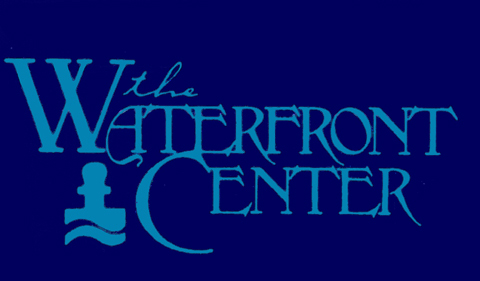
The Waterfront Center announces winners of the 2010
“Excellence on the Waterfront” Program
Click here to see the 2010 Awards Presentation
The Excellence on
the Waterfront Awards Program was initiated in 1987 with grants from the
National Endowment for the Arts Design Arts Program and the National Marine
Manufacturers Association. The honor awards were developed to recognize top
quality design and development work. Entries are accepted from around the world
for comprehensive plans, built projects and student work. The Center also
recognizes citizen’s efforts through a Clearwater Award named for the
non-profit group of that name working to clean up the Hudson River in New York.
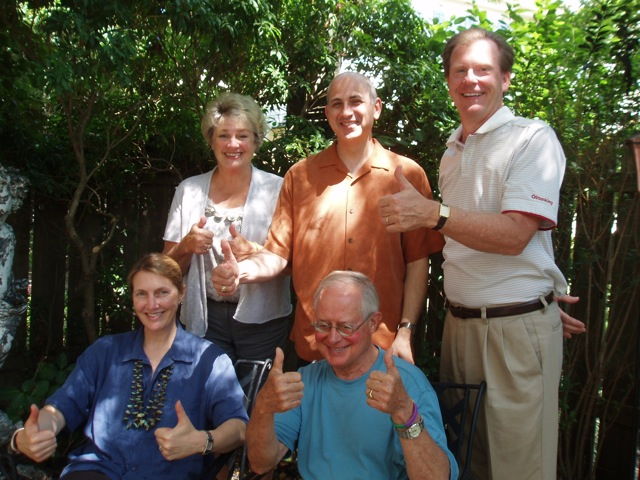
2010 Awards Jury
Standing: Jane Jacobsen, Jonathan Goldstick, Dave Mathewson
Seated: Fran Hegeler and Peter Brink
This year’s awards jury found many encouraging features among the strong field of 57 projects and plan entries in the program. Included was an emphasis in constructively reusing old industrial sites such as Ballast Point in Sydney, the Top Honor award recipient, and at Erie Basin in Brooklyn, N.Y. In each case, reflections of the industrial heritage, including materials, were celebrated in the design and project details. The jury felt this is an important message to waterfront communities where in some cases the temptation is to obliterate the industrial past.
A number of the entries demonstrated new approaches or at least heightened attention to flooding issues. Notable was the remake of a seawall in Blackpool, U.K., that for years had severed the city from its beach. The wall was taken down and replaced with graceful steps fully capable of withstanding storm waters. Also, the community boathouse in Hartford recognized here is completely floodable.
Sustainability, while not new this year or unique, was nonetheless a welcome emphasis in many entries, among winning applicants as well as many passed over. For instance, the Honor Award in plans for “Shoelace Park” along the Bronx River in New York includes sections on stormwater and floodplain resource management plus vegetation management and restoration. The San Francisco Salt Pond Restoration Project is a huge undertaking based in sound science. Sustainable practices are also a feature of the Top Honor award in Sydney.
Lastly, the theme of many this year’s entries was kids enjoying themselves.
For each winner, an entrant and co-entrant are listed, usually the project/plan sponsor and lead design firm. For Clearwater citizen's awards, the recipient and nominator are listed. The 2010 awards are listed by category. The jury statements for each award are posted.
2010 Waterfront Center award winners
Before After
• Ballast Point Park, Birchgrove, Sydney, New South Wales, Australia.
• Ballast Point Park, Birchgrove, Sydney, New South Wales, Australia.
Entrants: McGregor Coxall and Sydney Harbour Foreshore Authority, both Sydney, New South Wales, Australia.
Jury Statement
The dramatic transformation of a large tank farm to a public park and the unique and sustainable design features caught the jury’s attention. The reuse of material from the industry such as an old wall that is retained and the idea of taking rubble and recycling it by encasing it in mesh gabions as part of the park were notable. Old lumber was also redeployed in the buildings. A metal superstructure echoes one of the large storage tanks and incorporates a series of wind turbines. A series of grass circles are reminders of the former oil storage tanks.
In other words, not denying the industrial past but rather featuring it and reemploying various components, while at the same time creating a striking new public realm on one of Sydney harbour’s most prominent headlands.
The emphasis on sustainability includes managing all stormwater runoff so that it is filtered through planted areas and cleaned before entering the harbor. The symbolism of generating power from wind at the site of a former petroleum installation is major.
The Ballast Point Park came about as a result of citizen action that successfully blocked development of the site for residential use. The onetime grease manufacturing plant on Sydney Harbour is now a 2.8-hectare public space at the entrance to the Parramatta River with stunning views.
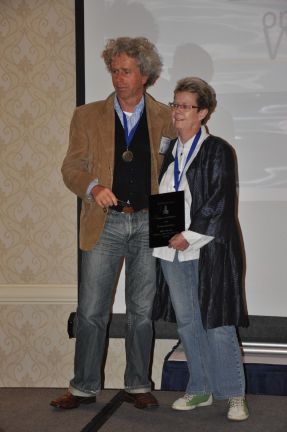
Phil Coxall and Di Talty receive the award
PROJECT HONOR AWARDS:

• Chicago Main Branch Riverwalk, Chicago River, Chicago, Illinois.
Entrants: Ross Barney Architects Inc. and the City of Chicago Department of Transportation, both Chicago, Illinois.
Jury Statement
This first-phase effort, between storied Michigan Avenue and State Street, involved adding 17 to 20 feet of river walk into the Chicago River. The result is the establishment of the first of what will be when completed eight distinct “rooms” between the core of the city and where the river branches north and south. Some of the rooms are embellished with public art and memorials. The jury said the river walk integrated itself with the city seamlessly and emphasized connectivity. The overhead reflective canopies under the bridges also impressed, offering both protection and catching light and watery images from the river.
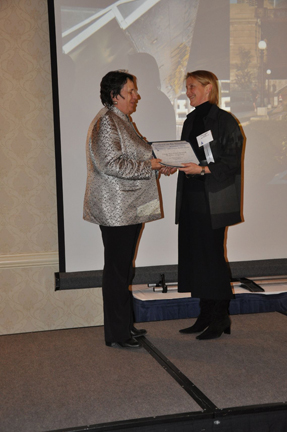
Carol Ross Barney receives the award
Category: Environmental
• South Bay Salt Pond Restoration Project, South San Francisco Bay, California.
Entrants: California State Coastal Conservancy, Oakland, and AECOM Design + Planning, San Francisco, both California.
Jury Statement
This truly massive undertaking, the restoration of over 15,000 acres of former industrial salt ponds into wetland habitats, is said to be the largest such effort on the West Coast. The ultimate goal is to restore 40,000 acres of lost tidal wetlands in the bay. The jury was impressed that the effort has its foundation in sound science, one of the judging criteria. This is a long-range undertaking, five years in the planning, and decades from completion. Researchers will learn how best to restore these areas and will apply lessons learned on the ground to future management practices. Public access along with interpretive panels has been provided so the people will learn from a living laboratory about this remarkable restoration.
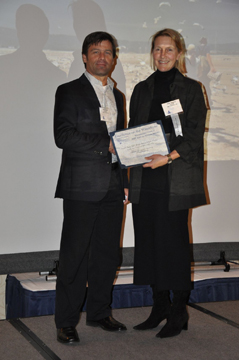
Jason Rowe receives the award
Category: Mixed Use:
• Greater Hartford Jaycees Community Boathouse, Riverside Park, Hartford, Connecticut.
Entrants: Riverfront Recapture and JCJ Architecture, both Hartford, Connecticut.
Jury Statement
The jury thought this a very special project, recognizing that its location on the banks of the Connecticut River is subject to floods and adopting a design that can handle same. They said it was as “design with nature” approach and marveled at the image showing the building, that houses expensive rowing shells, completely surrounded by water. It is a concrete core anchored on 45-foot pilings. The design reflects a Victorian heritage as Riverside Park was designed in the 1890’s by Frederick Law Olmsted’s sons. The addition of a second story allowed for community activities in the facility. Riverfront Recapture, the non-profit entity that built the boathouse rents the space and adjacent park area for all sorts of events.
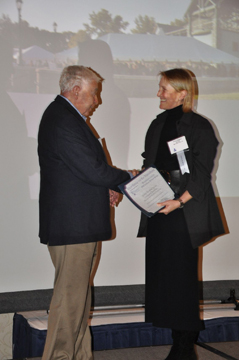
Joe Marfuggi Receives the award
Category: Park/Walkway/Recreational
Before After
• Erie Basin Park, Brooklyn, New York.
Entrants: Lee Weintraub Landscape Architecture LLC, Yonkers, New York, and IKEA Property Inc., Conshohocken, Pennsylvania.
Jury Statement
The “before and after” images of this project are stunning. The jury termed the area a true mess. But underneath the debris were industrial artifacts, including tools meticulously salvaged and repainted, as well as cranes (preserved) and cobblestones. The new additions to the park are meant to reflect the shipyard heritage here. Furnishings in the park use found materials, such as perforated metal, metal grilles and heavy timber. The park, nearly a mile long, connects to the evolving Red Hook neighborhood of Brooklyn. Significant is that the territory is owned by IKEA whose large box store is nearby but who will maintain the parkland in public use in perpetuity as a condition of its permit.
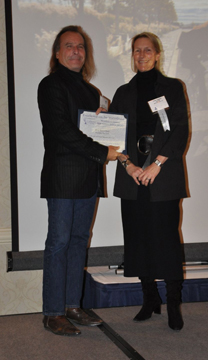
Lee Weintraub receives the award
Category: Park/Walkway/Recreational
• Red Ribbon Tanghe River Park, Qinghuangdao City, Heibi Province, China
Entrants: Turenscape, Beijing and LinaYang/Peng Yun, Landscape Bureau, Quinghuangdao City, Hebei Province, both China.
Jury Statement
The jury felt this was an amazing, artful transformation of a former garbage dump, where the secret is the minimal intervention into the landscape. This was done deliberately to preserve as much of the natural river corridor as possible. The signature ribbon is a vivid unifying element made of fiber steel. It stands 60 centimeters high and plants grow in strategically placed holes. The red ribbon runs 500 metes and provides at once lighting, seating, environmental interpretation and environmental orientation. It also provides breaks for animal crossings. Four pavilions are part of the ribbon and there are perennial flower gardens of white, yellow, purple and blue plants that act as a patchwork and help turn the degraded site into an attraction for nearby residents but leaving natural environment intact.
Category: Park/Walkway/Recreational
• Forks River Trail, Winnipeg, Manitoba, Canada.
Entrants: The Forks Renewal Corporation, Winnipeg, Manitoba, Canada.
Jury Statement
What has been accomplished here is an expansion of a small river trail into an 8.5-kilometer ice trail – expanding public access onto the river! Multiple winter activities are made possible, such as weekend hockey, curling, broomball and ice bike races. An estimated 450,000 skaters use the trail. Distinguishing the trail are five individually designed, eye-catching warming huts. The sponsoring organization, the Forks Renewal Corporation, worked with teams of artists and architects to create these imaginative symbols. The “forks” is where the Red and Assiniboine rivers join in downtown Winnipeg, meaning the icy river trail is accessible to many neighborhoods. What the jury liked was that Winnipeg was not “giving in” to their cold winters but rather celebrating it, which they felt could be inspiration for other northern cities.
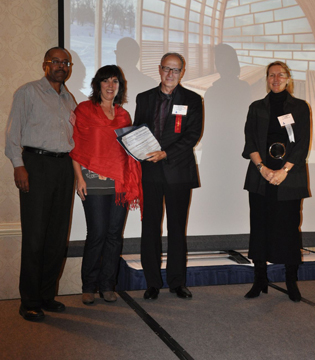
Toby Chase, Ginette Lavack Walters, and Jim August receive the award
Category: Public Works:
• Wilkes Barre Commons, Wilkes Barre, Luzerne County, Pennsylvania.
Entrants: The Forks Renewal Corporation, Winnipeg, Manitoba, Canada.
Jury Statement
Downtown Wilkes-Barre was severed from the Susquehanna River by an earth levee constructed after a major flood in 1936. After another flood in 1996, the Army Corps of Engineers proposed a higher levee which would have permanently separated the city and its river. The “big idea” here, inspired at a Waterfront Center presentation showing a riverfront park in Augusta, Georgia, was to punch holes in the levee wall and install gates. Rather than a forbidding wall there are now two 60-foot openings to the river park and its plantings and various “rooms.” The gates can be rolled shut in flood conditions. Across the top of the levee is a wide promenade that continues over the gates. It connects with a regional greenway system at either end. In the entire project represents an investment of $65 million, from county and Federal sources, a sizeable investment for a city of this size. Features include an amphitheater, a river landing suitable for arts festivals and restored wildlife habitats. The jury saw this work as a flood control project acting as a park. They felt the result said to the citizens, “Take me to the river!”
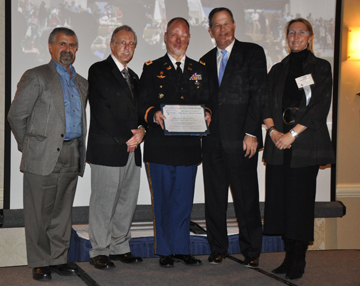
Varoujian Hagopian, Jack Murphy , Col. Dave Anderson , and Jim Brozena receive the award
Category: Public Works:
• Blackpool Promenade + Coastal Protection, Blackpool, United Kingdom,
Entrants: AECOM Design + Planning, San Francisco, California, and Reblackpool, Blackpool, United Kingdom.
A 30-foot seawall built here in Victoria times to protect the city from storms was frequently over-topped in modern times. The coastal protection project recognized here both dealt with the flooding issue and simultaneously changed the entire relationship of Blackpool to the sea. The serpentine steps, nearly two miles long, merge onto the beach and allow easy access. The specific design was based on extensive wave tank analysis. Each step serves to diffuse the energy of storm waves. The seawall’s color was picked to exactly match the famed beach here, and native maritime plant species are used on the promenade. The new seawall is part of a larger effort at the rejuvenation of Blackpool, whose attractions have become worn and suffer from easy access to overseas resorts.
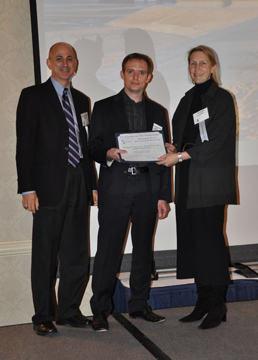
James Haigstreeter receives the award
Category: Plan Honor Awards:
• Master Plan for Shoelace Park, Bronx, New York.
Entrants: Mathews Nielsen Landscape Architects and Bronx River Alliance.
Jury Statement
The plan being honored here traces its history to the Bronx River Restoration founded in 1974, and its successor organization, the Bronx River Alliance, working with the City Department of Parks and Recreation. The plan provides design principles and guidance for Shoelace Park and Fort Knox Park, key components of the eight-mile Bronx River Greenway. Two hallmarks of this effort were on the one hand, extensive community consultation, all the more important as this river and greenway are in an underserved area. And, the jury saw the plan as clear, unpretentious and practical. Part of the community outreach was establishment of a Youth Design Team that took part in two design charettes, whose outcomes were shared with two subsequent community-wide design charettes. There was also a Shoelace Park Web site. One of the outcomes was a proposed reduction of a pathway along the river from 40 feet to 17, allowing for plazas, play areas, fitness stations and stormwater treatment plus a bike trail and walkways. The jury admired the many poetic images throughout the plan document.
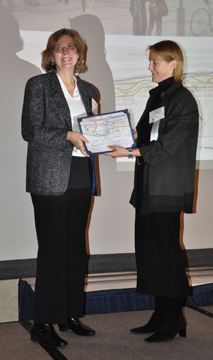
Kim Mathews
receives the award
Category: Clearwater Awards
•Center for Wooden Boats, Lake Union, Seattle, Washington.
Nominated by: Flo Lentz, 4Culture, Seattle, Washington.
Jury Statement
What’s honored here is the creativity and imagination of Dick and Colleen Wagner in 1968 establishing, in their kitchen, a place for people with an interest in boats and woodworking could gather. Their sense was that wooden boat-building was a dying art – heightened by the fact that books on the subject in the library were dated 1890’s. Meetings followed, boats were assembled, and by 1978 a wooden boat festival was held and the future Center for Wooden Boats was launched. Today, this pioneering and visionary institution with its large volunteer corps serves over 100,000 people annually, without losing its informality or creativity. The Center is an anchor of a new 12-acre Lake Union Park.
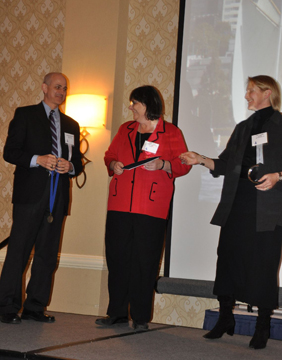
Betsy Davis
receives the award
Category: Clearwater Awards
• Vicki Beiriger Richmond, Kansas City, Missouri.
Nominated by: Michael Burke, King Hershey PC/Port Authority of Kansas City, Missouri.
Jury Statement
The person recognized here is part of Missouri River Relief, a volunteer, grassroots organization dedicated to river clean ups and education. A first initiative of the group was to bring a barge to the area in 2001 for the first major river cleanup. The group has now hosted 55 such cleanups involving 12,000 volunteers, and has cleaned an astonishing 537 tons of trash over nearly 600 miles of riverfront. Vicki Richmond since 2002 has been Middle Reach Program Manager for Missouri River Relief, a not-for-profit organization. Likewise she has served as an educator for another non-profit, the Little Blue River Watershed Coalition, among her numerous civic activities.
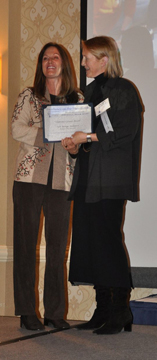
Vicki
Richmond receives the award
Category: Clearwater Awards
• Healthy River, Healthy Communities, San Diego, California.
Nominated by: Rick Barrett, San Diego, California.
Jury Statement
The non-profit San Diego River Foundation, founded in 2001, is recognized for its stewardship of the San Diego River Watershed in general and its core volunteer action group in particular, the Health River Healthy Communities program. The group conducts surveys to identify problem areas and then devises projects to service them. Monthly monitoring and water quality testing is conducted to check the efficacy of the efforts. Involved is trash removal, pollution cleanup and elimination of invasive plants. As of mid-2010, the San Diego River Park Foundation and its volunteers have removed over one million pounds of trash and debris.

Rob
Hutsel receives the award
Ann Breen and Dick Rigby are the co-founders and co-directors of the Waterfront Center, organized in 1981.
For additional information and photographs, contact:
Kathleen Ewing
The Waterfront Center
PO Box 32129
Washington, DC 20007
202-337-0356 Fax: 202-986-0448
©
2007 The
Waterfront Center
Content and photographs on this site may not be reproduced without express
permission from The Waterfront Center.